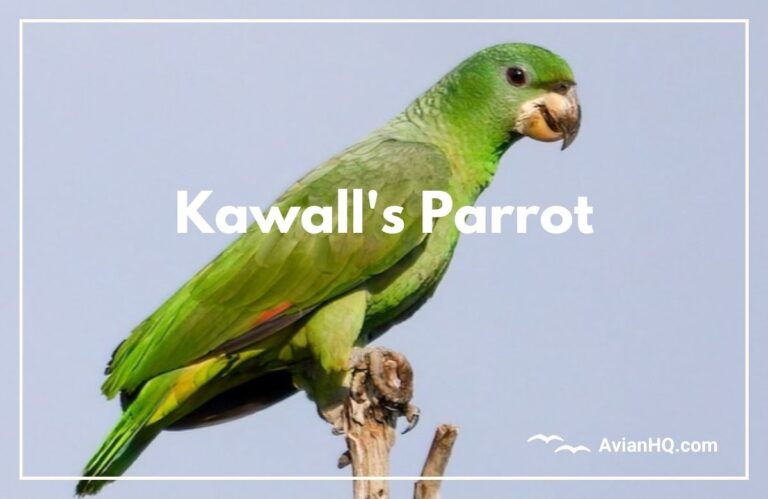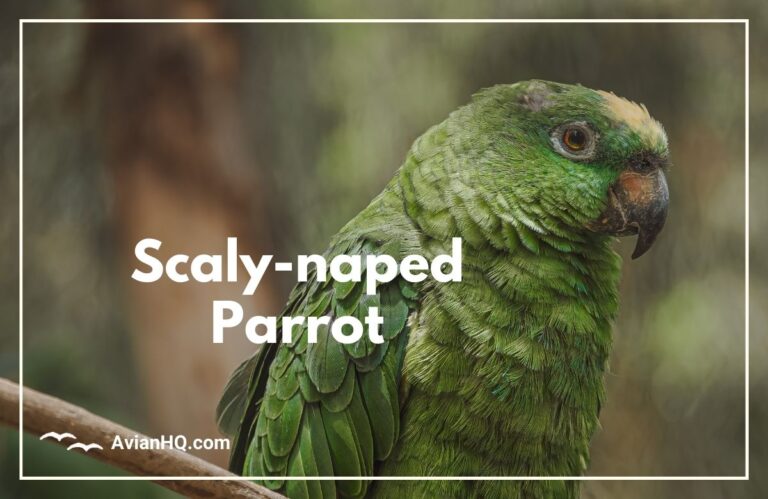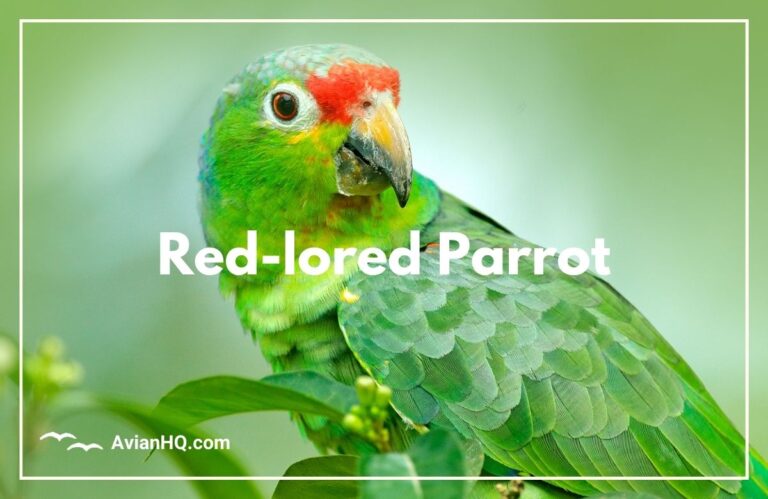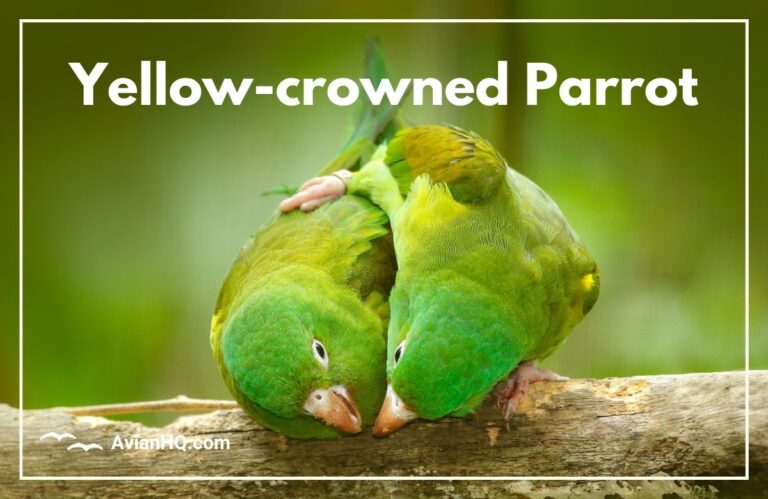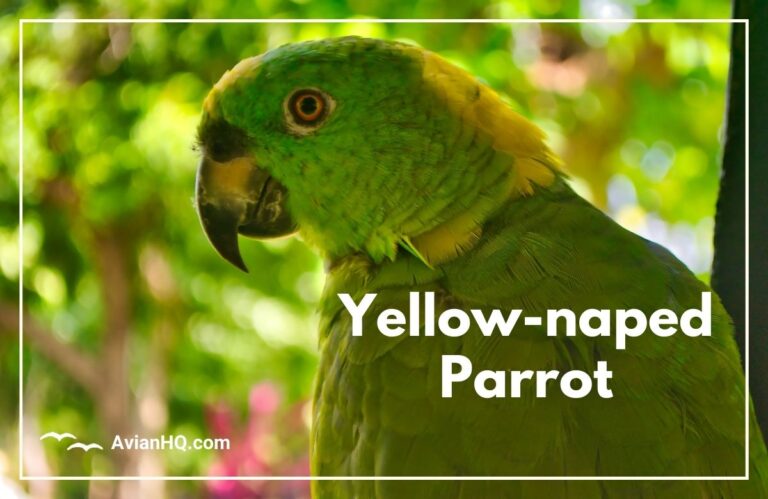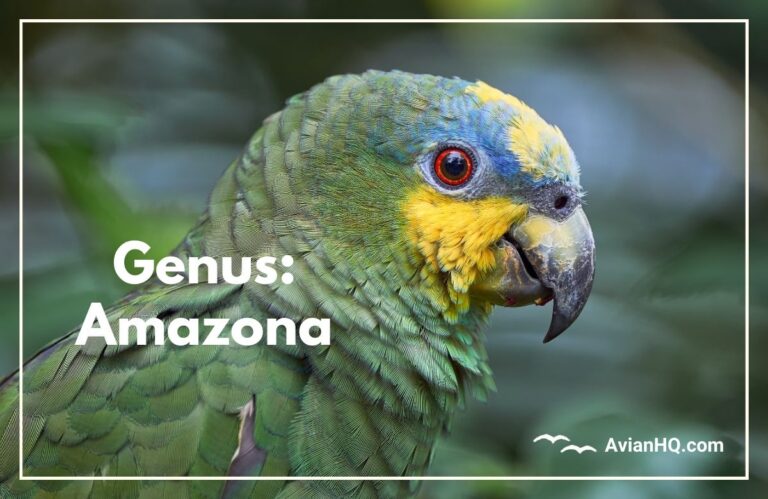Blue-fronted Amazon (Amazona aestiva)
The Blue-fronted Amazon parrot (Amazona aestiva), also known as a Turquoise-fronted Amazon is a gorgeous green parrot with a distinctive blue patch on its forehead. If you’re looking to bring one of these charismatic parrots into your home, read on to learn all about their history, physical features, habitat, behavior, care requirements, and more.
These medium-sized parrots measure between 13-15 inches (35-38 cm) from head to tail and weigh 13-17 ounces (375-500 grams). They have a mostly green body, with a stunning patch of blue feathers on the forehead that gives them their common name. The amount of blue and yellow on the head varies quite a bit between individuals.
Blue-fronted Amazons inhabit wooded regions from Bolivia to Brazil, Paraguay and Argentina. They form large, noisy flocks and commune together at shared roost sites. Their high energy, social nature carries over as pets. They demand regular interaction but can also amuse themselves for hours with the right toys.
While Blue-fronted Amazons remain relatively common in parts of South America, their populations are in decline due to heavy trapping for the pet trade and habitat loss. Their engaging personalities and ability to talk make them extremely popular companion parrots. However, their loud vocalizations mean they may not make the best apartment pets.
If a Blue-fronted Amazon sounds like the right fit for you, read on to learn all about caring for one of these charismatic parrots!
History and Taxonomy
The Blue-fronted Amazon parrot has a long history as a recognized species. Swedish botanist Carl Linnaeus first described the species in 1758 in his influential work Systema Naturae. He gave it the scientific name Amazona aestiva, with the species name aestiva meaning “of the summer” in Latin.
Scientific Classification
The Blue-fronted Amazon belongs to the following scientific classification:
- Kingdom: Animalia
- Phylum: Chordata
- Class: Aves
- Order: Psittaciformes
- Family: Psittacidae
- Genus: Amazona
- Species: Amazona aestiva
Subspecies
There are two recognized subspecies of the Blue-fronted Amazon:
- A. a. aestiva – The nominate subspecies found in eastern Brazil. It has red feathers on the bend of the wing.
- A. a. xanthopteryx – Native to parts of Bolivia, Brazil, Paraguay and Argentina. It has yellow feathers on the bend of the wing and more yellow on the head.
The subspecies freely interbreed where their ranges overlap. There is some debate over whether they should be considered separate species. Some taxonomists have classified them this way in the past.
Taxonomy Confusion
The similar appearances of Blue-fronted Amazons and Yellow-winged Amazons have caused some taxonomic confusion. The Yellow-winged Amazon (Amazona xanthopteryx) was previously considered a subspecies of the Blue-fronted. But it is now recognized as a distinct, yet closely related, species.
Physical Appearance
The Blue-fronted Amazon is a stunning, mostly green parrot with a distinctive blue marking on its forehead. But there is actually quite a bit of variation in the color patterns between individuals.
Size and Weight
These are medium-sized parrots, measuring 13-15 inches (35-38 cm) from head to tail. Their weight ranges from 13-17 ounces (375-500 grams).
The A. a. xanthopteryx subspecies is slightly heavier on average than A. a. aestiva.
Plumage and Markings
- Predominantly green feathers over most of the body and wings
- Blue patch on the forehead above the culmen
- Amount of blue varies from none to nearly the entire head blue
- Yellow feathers in areas around the blue, including above, below, and behind the head
- Bright red feathers on the bend of the wing (shoulders)
- More yellow in this area in A. a. xanthopteryx
- Tail is green with some red at the base
- Flight feathers may show some violet tones
Bill, Eyes, and Feet
- Bill is black
- Eyes are orange with a narrow white eye-ring
- Feet are gray
Sexual Dimorphism
There are no visually identifiable differences between male and female Blue-fronted Amazons. The only way to determine the sex is through DNA testing or surgical sexing methods.
Color Mutations
Some color mutations have been bred in captivity, including:
- Cinnamon – brownish-yellow body plumage
- Lutino – replaces yellow with white
- Blue – mostly blue body with some yellow patches
Habitat and Distribution
Blue-fronted Amazons inhabit a large swath of South America across Brazil, Bolivia, Paraguay and Argentina. They thrive in a variety of wooded environments.
Native Range
The native range extends over eastern and northern Bolivia, eastern Brazil, Paraguay and northern Argentina.
Specifically:
- A. a. aestiva – Inland eastern Brazil, from Pernambuco and southern Para south to São Paulo and Mato Grosso
- A. a. xanthopteryx – Southern Mato Grosso, Brazil to northern Argentina
Natural Habitat
Blue-fronted Amazons occupy a range of wooded habitats:
- Tropical and subtropical moist forests
- Savannas
- Scrub forests
- Palm groves
- Areas with scattered trees
They generally avoid dense, humid rainforests like the Amazon.
Elevation Range
In Bolivia, these parrots have been spotted up to elevations of 5,200 feet (1,600 meters). They are typically found at lower elevations elsewhere.
Introduced Populations
A small feral breeding colony is now established in Stuttgart, Germany. This likely traces back to escaped pet birds that formed a population over time. There have also been some sightings in Puerto Rico, but no evidence of sustained breeding.
Diet and Feeding
The Blue-fronted Amazon is an opportunistic forager that utilizes a diverse array of food sources in the wild. It exploits readily available and abundant food items including fruits, seeds, nuts, and flowers.
Natural Diet
The wild diet consists primarily of:
- Fruits – Figs, palms, cacti, citrus, pomegranates
- Flowers – Trumpet trees, mulberries
- Seeds and nuts – From trees like acacia and mesquite
Some specific plants they feed on:
- Melia
- Aspidosperma
- Prosopis
- Schinopsis
- Ziziphus
They supplement with occasional protein sources such as insect larvae or eggs on rare occasions.
Feeding Behavior
These highly social parrots form large, noisy flocks when feeding. The flock structure offers safety in numbers from predators.
They may also gather in pairs or smaller family groups to exploit smaller concentrated food bonanzas. Their strong beaks allow them to access well-protected fruits and seeds.
At times they descend to agricultural fields and orchards, where they can cause considerable crop damage. This earns them pest status with some farmers.
Captive Diet
In captivity, Blue-fronted Amazons should be fed a nutritionally balanced diet including:
- High quality seed mix
- Specially formulated pellets
- Chopped fruits and vegetables like apples, oranges, corn, peas, carrots
- Limited nuts, seeds, grains as treats
Clean, fresh drinking water must be continually available.
Breeding and Reproduction
Blue-fronted Amazons reach breeding age around 3 years old. But they may not successfully breed until age 5. The breeding season spans spring and summer in their natural range.
Nesting Sites
These parrots nest in tree cavities, either natural hollows or old woodpecker holes. The nest is typically situated around 30 feet (9 meters) high up in the tree. More rarely, they may nest in cliff crevices or arboreal termite mounds.
Clutch Size
The average clutch contains 3-4 white eggs. The eggs measure about 1.5 x 1.2 inches (38 x 30 mm) in size.
Incubation
Only the female incubates the eggs. The incubation period lasts around 28 days before the eggs hatch.
Fledgling Phase
The chicks are altricial at hatching, with closed eyes and little to no down. Both parents feed and care for the young. The chicks develop and grow quickly, leaving the nest at 8-9 weeks old.
Breeding in Captivity
Breeding Blue-fronted Amazons in an aviary or cage requires patience. It takes time for pairs to bond and feel secure enough to attempt nesting. Providing proper nest boxes, nutrition, and seasonal light/temperature changes helps stimulate breeding behavior.
Behavior and Ecology
The Blue-fronted Amazon is a highly social and gregarious species, both in the wild and captivity. Their behavior and interactions are important to understand.
Flock Sizes
Blue-fronted Amazons form large communal flocks, especially when feeding and roosting. Flocks may number in the dozens to hundreds of birds. The flock social structure offers safety, easier food finding, and opportunities to locate potential mates.
Roosting
At night, wild flocks will converge in common roosting sites. These tend to be tall trees that offer protection from predators. Collective roosting enhances safety and heat conservation.
Feeding and Foraging
During the day, Blue-fronted Amazons break off into small groups, pairs, or family units to search for food. Their strong beaks allow them to access fruits and nuts other birds cannot. They are resourceful foragers that exploit seasonally available foods.
Interspecies Interactions
These gregarious parrots will readily mingle and associate with other parrot species. Mixed flocks containing macaws, conures, and Amazon parrots often form, especially at shared feeding grounds.
The flock structure provides enhanced awareness of predators like hawk and falcon species that may target young, old, or infirm individuals. Their loud vocalizations help alert others to threats.
Behavior as Pets
In captivity, Blue-fronted Amazons retain their exuberant, social personalities. They demand regular interaction and mental stimulation. Without proper attention, they can become noisy or even destructive. But their charm and intelligence make them wonderful pets for the right owners.
Conservation Status
While still relatively widespread, Blue-fronted Amazon populations are decreasing across their native range. Loss of habitat and trapping for the pet trade pose long-term threats to the species.
IUCN Red List Status
The IUCN Red List categorizes Blue-fronted Amazons as Near Threatened. Their numbers today are estimated at less than one million birds.
Population Trends
Exact population sizes are uncertain. But declines have been observed across Brazil, Bolivia, Argentina and other parts of their range. The trends point to an overall reduction in numbers.
Major Threats
The two main threats facing Blue-fronted Amazons are:
- Trapping for Pet Trade: Since the 1980s, over 400,000 wild Blue-fronted Amazons have been legally exported. Illegal trapping further reduces their populations. Their popularity as pets fuels continual capture from the wild.
- Habitat Destruction: Logging, agriculture, infrastructure, and other human activities have led to deforestation across their native range. Loss of nesting and feeding habitat impacts both wild and captive populations.
Conservation Actions
- CITES Appendix II listing monitors/limits legal trade
- Habitat preservation is critical for population viability
- Further field studies needed to fully assess current population sizes and risks
Bolstering protected forest areas and regulating the international live bird trade are key conservation priorities going forward. Responsible aviculture practices also help protect Blue-fronted Amazons into the future.
Cultural Significance
The Blue-fronted Amazon holds a special significance and appeal among aviculturalists and pet owners. Their stunning colors, playful nature, longevity, and talking ability make them extremely desirable companion parrots.
Popularity as Pets
Blue-fronted Amazons are among the most commonly kept Amazon parrots. Their populations are anchored by sustained captive breeding around the world. Responsible breeders aim to manage captive genetic diversity.
If properly socialized, Blue-fronted Amazons make delightful pets. Their clownish antics and ability to mimic noises provide endless entertainment. They bond strongly with their owners and can learn scores of words and phrases.
However, their screaming and destructive tendencies mean they are not ideal for all owners or living situations. Their care requires time, patience, ample space, and acceptance of loud vocalizations.
Aviculture Challenges
Maintaining Blue-fronted Amazons presents challenges for aviculturalists seeking to breed this species responsibly. Careful selection of breeding stock, control of environmental factors, and interventions like hand-feeding chicks are often required for success.
By sharing information on breeding techniques, new color mutations, and ideal captive care practices, aviculturists help safeguard the future of this species in and out of the wild.
Conservation Flagship
Increased public affection for Blue-fronted Amazons advanced by the pet trade also boosts overall conservation efforts. Like macaws and cockatoos, they serve as flagship species for securing habitat protections where they naturally occur.
Their popularity spotlights the peril facing South American forests and grasslands. Preserving wild areas not only benefits Blue-fronted Amazons, but all native plants and animals sharing those ecosystems. Their appeal thus indirectly aids broader conservation goals.
Conclusion
The Blue-fronted Amazon is a remarkable parrot species renowned for its intelligence, vocalizations, longevity, and captivating personalities. As pets, they offer years of enjoyment but require extensive care and interaction.
While still widespread, loss of habitat and overcollection are resulting in population declines across their native ranges in South America. Their cultural popularity buoyed by the pet trade may assist conservation efforts if directed effectively.
Responsible aviculture practices and habitat protection initiatives both play key roles for the future welfare of the Blue-fronted Amazon. With diligent management both in captivity and the wild, these iconic parrots can continue brightening the forests and homes of South America for decades to come through their charming green and blue plumage.
Key Takeaways
- Striking green parrots with signature blue foreheads
- Two subspecies in eastern Brazil to Argentina
- Form noisy communal flocks in forests and savannas
- Intelligent, vocal, energetic personalities as pets
- Near Threatened conservation status
- Trapping and deforestation require monitoring
- Captive breeding helps anchor populations
- Can live 50+ years with proper care and diet
Owning a Blue-fronted Amazon is an undertaking, but their gorgeous colors and delightful antics repay the commitment these birds demand. With patience and dedication, you’ll be rewarded with a lifetime avian companion.


